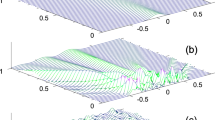Abstract
Quantum particles in a potential are described by classical statistical probabilities. We formulate a basic time evolution law for the probability distribution of classical position and momentum such that all known quantum phenomena follow, including interference or tunneling. The appropriate quantum observables for position and momentum contain a statistical part which reflects the roughness of the probability distribution. “Zwitters” realize a continuous interpolation between quantum and classical particles. Such objects may provide for an effective one-particle description of classical or quantum collective states as droplets of a liquid, macromolecules or a Bose-Einstein condensate. They may also be used for quantitative fundamental tests of quantum mechanics. We show that the ground state for zwitters has no longer a sharp energy. This feature permits to put quantitative experimental bounds on a small parameter for possible deviations from quantum mechanics.
Similar content being viewed by others
References
Couder, Y., Fort, E.: Phys. Rev. Lett. 97, 154101 (2006)
Eddi, A., Fort, E., Moisy, F., Couder, Y.: Phys. Rev. Lett. 102, 240401 (2009)
Wetterich, C.: Ann. Phys. 325, 1359 (2010)
Wetterich, C.: arXiv:0911.1261
Wetterich, C.: Ann. Phys. 325, 852 (2010). arXiv:0906.4919
Wetterich, C.: Ann. Phys. 522, 467 (2010). arXiv:0810.0985
Wetterich, C.: J. Phys. 174, 012008 (2009). arXiv:0811.0927
Wetterich, C.: AIP Conf. Proc. 1232, 175 (2010). arXiv:0809.2671
Bell, J.S.: Physica 1, 195 (1964)
Wetterich, C.: Ann. Phys. 522, 807 (2010). arXiv:0904.3048
Volovich, I.V.: arXiv:0907.2445
Koopman, B.: Proc. Acad. Sci. 17, 315 (1931)
von Neumann, J.: Ann. Math. 33, 587 (1932)
von Neumann, J.: Ann. Math. 33, 789 (1932)
Mauro, D.: arXiv:quant-ph/0105112
Gozzi, E., Reuter, M., Thacker, W.: Phys. Rev. D 40, 3363 (1989)
Man’ko, V., Marmo, G.: Phys. Scr. 60, 111 (1999)
Gozzi, E., Mauro, D., Silvestri, A.: Int. J. Mod. Phys. A 20, 5009 (2005)
Nikolic, H.: arXiv:0707.2319
Wigner, E.P.: Phys. Rev. 40, 749 (1932)
Moyal, J.E.: Proc. Camb. Philos. Soc. 45, 99 (1949)
Kochen, S., Specker, E.P.: J. Math. Mech. 17, 59 (1967)
Mermin, N.D.: Phys. Rev. Lett. 65, 3373 (1990)
Peres, A.: J. Phys. A, Math. Gen. 24, L175 (1991)
Straumann, N.: arXiv:0801.4931
Wetterich, C.: In: Elze, T. (ed.) Decoherence and Entropy in Complex Systems, p. 180. Springer, Berlin (2004). arXiv:quant-ph/0212031
Clauser, J., Horne, M., Shimony, A., Holt, R.: Phys. Rev. Lett. 23, 880 (1969)
Bell, J.: In: d’Espagnat, B. (ed.) Foundations of Quantum Mechanics, p. 171. Academic Press, New York (1971)
Clauser, J., Horne, M.: Phys. Rev. D 10, 526 (1974)
Clauser, J., Shimony, A.: Rep. Prog. Phys. 41, 1881 (1978)
Wetterich, C.: Nucl. Phys. B 314, 40 (1989)
Wetterich, C.: Nucl. Phys. B 397, 299 (1993)
Einstein, A., Podolski, B., Rosen, N.: Phys. Rev. 47, 777 (1935)
Birkhoff, G., von Neumann, J.: The logic of quantum mechanics 37 (1936)
von Neumann, J.: Mathematical Foundations of Quantum Mechanics. Princeton University Press, Princeton (1955)
Misra, B.: In: Enz, C.P., Mehra, J. (eds.) Physical Reality and Mathematical Description, p. 455. Reidel, Dordrecht (1974)
Holevo, A.S.: Probabilistic and Statistical Aspects of Quantum Theory. North Holland, Amsterdam (1982)
Ali, S.T., Prugovecki, E.: J. Math. Phys. 18, 219 (1977)
Singer, M., Stulpe, W.: J. Math. Phys. 33, 131 (1992)
Beltrametti, E., Bugajski, S.: J. Phys. A, Math. Gen. 28, 3329 (1995)
Beltrametti, E., Bugajski, S.: Int. J. Theor. Phys. 34, 1221 (1995)
Bugajski, S.: Int. J. Theor. Phys. 35, 2229 (1996)
Stulpe, W., Busch, P.: J. Math. Phys. 49, 3 (2008)
Wetterich, C.: arXiv:1002.2593
Wetterich, C.: Ann. Phys. 325, 2750 (2010)
Wetterich, C.: Ann. Phys. 326, 2243 (2011)
Wetterich, C.: arXiv:1111.4115
Zeh, H.D.: Found. Phys. 1, 69 (1970)
Joos, E., Zeh, H.D.: Z. Phys. B 59, 273 (1985)
Joos, E., Zeh, H.D., Kiefer, C., Giulini, D., Kupsch, J., Stamatescu, I.-O.: Decoherence and the Appearance of the Classical World. Springer, Berlin (2003)
Zurek, W.: Rev. Mod. Phys. 75, 715 (2003)
Gemmel, C., et al.: Eur. Phys. J. D 57, 303 (2010)
Author information
Authors and Affiliations
Corresponding author
Appendix: Absence of Conserved Energy for Zwitters
Appendix: Absence of Conserved Energy for Zwitters
In this appendix we argue that for zwitters defined by the particular interpolating Hamiltonian H γ (94) no conserved energy exists (besides the trivially conserved generator of time translations H γ itself). This involves the search for an energy operator \(\hat{H}\) which commutes with H γ . We have therefore to explore the commutation relations for different pieces that could be additive building blocks of \(\hat{H}\) with H W and H L .
With
one has the commutation relations
and
We notice that the last four commutators typically differ from zero such that the existence of a conserved energy is not obvious.
Next we investigate the commutation relations for different possible pieces composing \(\hat{H}\). We list
and
as well as
and

For the energy observable \(\hat{H}\) we make the ansatz of a linear combination
This yields the commutation relation with H γ

The classical Hamiltonian corresponds to \(A=\tilde{A}=1/4\), B=−1/4, \(E=\tilde{E}=0\), F=1 and commutes with H γ for sin2 γ=1, while the quantum Hamiltonian obeys A=E=1, \(\tilde{A}=B=\tilde{E}=F=0\), and commutes with H γ for cos2 γ=1. For intermediate values of γ and generic unharmonic potentials the relation \([H_{\gamma},\hat{H}]=0\) has no nontrivial solution. Adding further terms to \(\hat{H}\) does not change the situation. Generically, no nontrivial conserved energy exists for zwitters of the type defined by Eq. (94).
As an example we may consider the “zwitter energy”
which interpolates between the quantum energy for γ=0 and the classical energy for γ=π/2. This corresponds to \(A=\cos ^{2}\gamma +\sin^{2}\gamma/4,\tilde{A}=-B=\sin^{2}\gamma/4,~E=\cos^{2}\gamma,\tilde{E}=0,~F=\sin^{2}\gamma\) and we infer the commutator

Performing a Taylor expansion of V using Eq. (113) we find that in leading order (e=0) only the cubic term contributes to the commutator
As it should be, the commutator vanishes for γ=0,π/2 and for a harmonic potential.
Rights and permissions
About this article
Cite this article
Wetterich, C. Quantum Particles from Classical Probabilities in Phase Space. Int J Theor Phys 51, 3236–3273 (2012). https://doi.org/10.1007/s10773-012-1205-8
Received:
Accepted:
Published:
Issue Date:
DOI: https://doi.org/10.1007/s10773-012-1205-8




